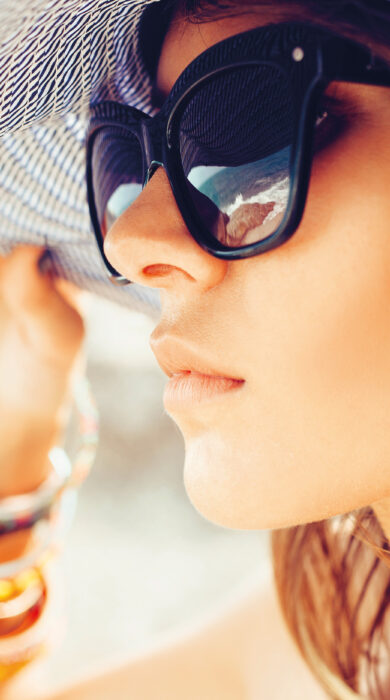
Travel Safe & Well
Why it’s important to take care of your eye health when you travel
Having an eye for adventure is one thing, but you still have to take care of your vision while you travel, writes optometrist Mark Holloway…
It’s always exciting to plan a trip away, but we often forget that a new environment can also be a bit of an assault on our body and senses, especially when it comes to our eyes.
Long-haul flights, for example, often mean a lack of sleep and bloodshot eyes – caused by tiny blood vessels on the eyeball dilating. Circulated air in a pressure-controlled cabin can also reduce moisture on the surface of your eyes, which may cause them to become dry and irritated. The quickest and easiest way to refresh them in both situations is to use eye drops and stay hydrated.
However, the biggest threat to your eyes is the sun. Photokeratitis may be an unfamiliar term to many but it’s essentially sunburn of the eye, caused by overexposure to ultraviolet light. It’s easy to develop when travelling, with symptoms including redness, pain and, sometimes, blurred vision.
It’s not just the beach that increases your risk of photokeratitis. Sunlight reflecting off snow is just as dangerous, resulting in what is often called snow blindness. Its symptoms (red eyes, tearing, light sensitivity) usually develop six to 12 hours after UV exposure,
and although these are temporary, they are the result of eye damage, so it’s vital to wear the right protection.
According to a study by Specsavers, one in four UK adults buy sunglasses based on style when they should be protecting their eyes. Wraparound glasses, for example, offer greater coverage, while lenses should carry the CE mark and have a value of UV 400, as this means they provide nearly 100% protection from ultraviolet light.
The rise in solar-eclipse tourism offers another potential danger. Up to 4 million Americans were estimated to have travelled to viewing spots for last April’s Great American Eclipse. But it’s vital to remember that sunglasses are just not strong enough for viewing an eclipse, even the ones that provide 100% UV protection. You should only use ISO-certified solar-eclipse glasses, because these block 1,000 times more sunlight than standard sunglasses. It’s worth bearing in mind for the next total solar eclipse – in Europe in 2026.
Remember, you only get one pair of eyes, but by taking precautions, being aware and prioritising eye care while you travel, you will ensure they return home as refreshed as the rest of you.
4 tips to keep your eyes in shape while you travel
1. Don’t mistake anti-glare lenses for sun protection. Polarised sunglasses are increasingly popular, but they don’t automatically give higher levels of UV protection.
2. Eye drops such as TheraTears are a travel essential, providing relief for dry, irritated or sore eyes caused by a lack of humidity, increased exposure to sunlight or disrupted sleep.
3. It’s important to wear goggles in any pool. Conjunctivitis is a common eye infection that can be caused by extended contact with chlorine. Even in the short term, this chemical plays havoc with the eyes because it strips away the film that protects your cornea, causing eye irritation. And don’t forget that swimming in contact lenses is never recommended, often leading to painful and nasty infections.
4. Pack an extra pair of sunglasses, prescription glasses or contact lenses. Don’t waste your trip tracking down an English-speaking optician.
Mark Holloway is an optometrist and practice owner at Thomas & Holloway Opticians, Dronfield, East Derbyshire.
Eyecare by numbers
37% of UK adults are not aware that sunglasses have different levels of UV protection.
2/3 of UK adults don’t wear their day-to-day contact lenses or glasses on holiday, prioritising looks over eye care and risking their vision while away.
*Stats from reports by Specsavers and Optical Express
All content is for informational purposes only and does not constitute medical advice, treatment or diagnosis. Consult a healthcare professional before taking action




















